Media Watch, Honolulu Star Advertiser, 15 January 2012

[…] The current theory is that the ancient ancestors of today’s Hawaiian monk seals began exploring from their original home in the Caribbean 3 million years ago through what is now Central America during a time of global climate change, said Charles Littnan, program leader for the National Oceanic and Atmospheric Administration’s Hawaiian monk seals research.
“We don’t know how long that immigration took to occur, perhaps hundreds of thousands of years,” Littnan said. “We do know that quite dramatic climate change was happening, and these are tropical animals that will have to go to where they are better adapted to survive. They probably went to other areas and didn’t survive. But Hawaii was this perfect match for this far-traveling seafarer.” […]
Source: The Hawaiian Monk Seal, Living Fossil, Dan Nakaso, Special Report, Honolulu Star Advertiser, 15 January 2012. [PDF 20.2 MB]

 […] Since the early 1990s, when sightings of the rare creatures became a regular appearance throughout the inhabited Hawaiian Islands, tourists have flocked to take their pictures. Monk seal images now adorn magazines, postcards, T-shirts and caps. Diligent volunteers erect barrier ropes around sun-bathing seals, track their movements and guard their pups.
[…] Since the early 1990s, when sightings of the rare creatures became a regular appearance throughout the inhabited Hawaiian Islands, tourists have flocked to take their pictures. Monk seal images now adorn magazines, postcards, T-shirts and caps. Diligent volunteers erect barrier ropes around sun-bathing seals, track their movements and guard their pups.